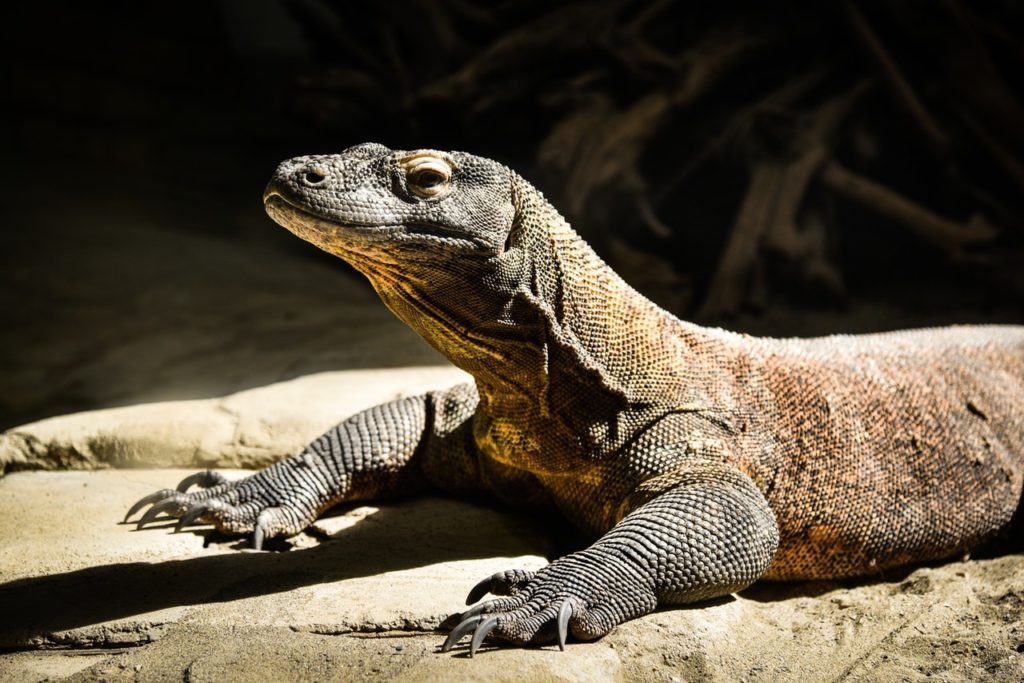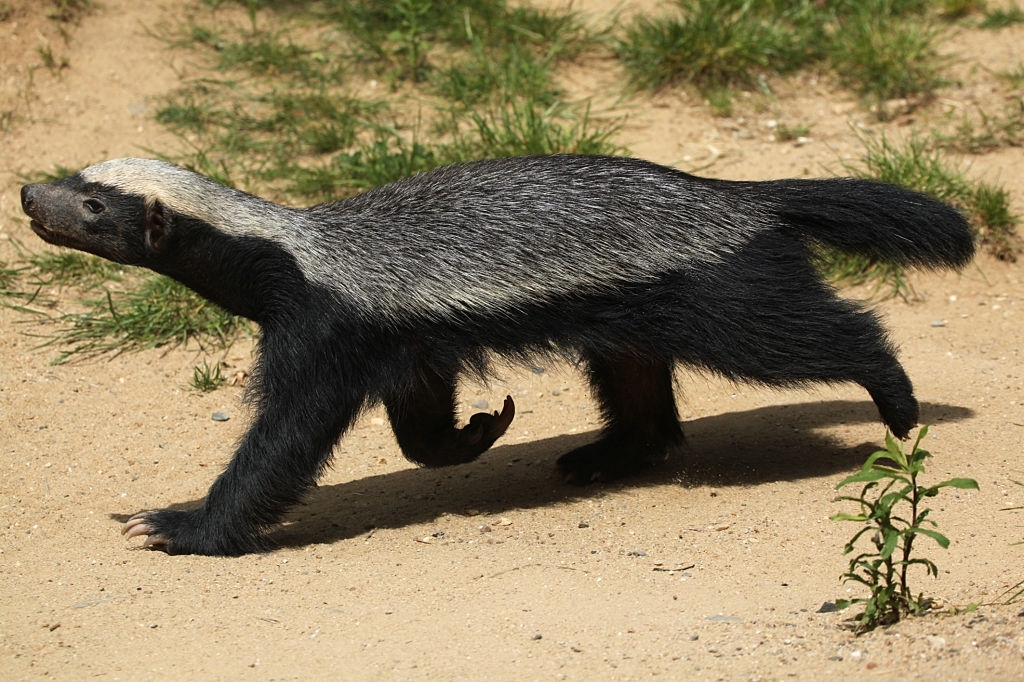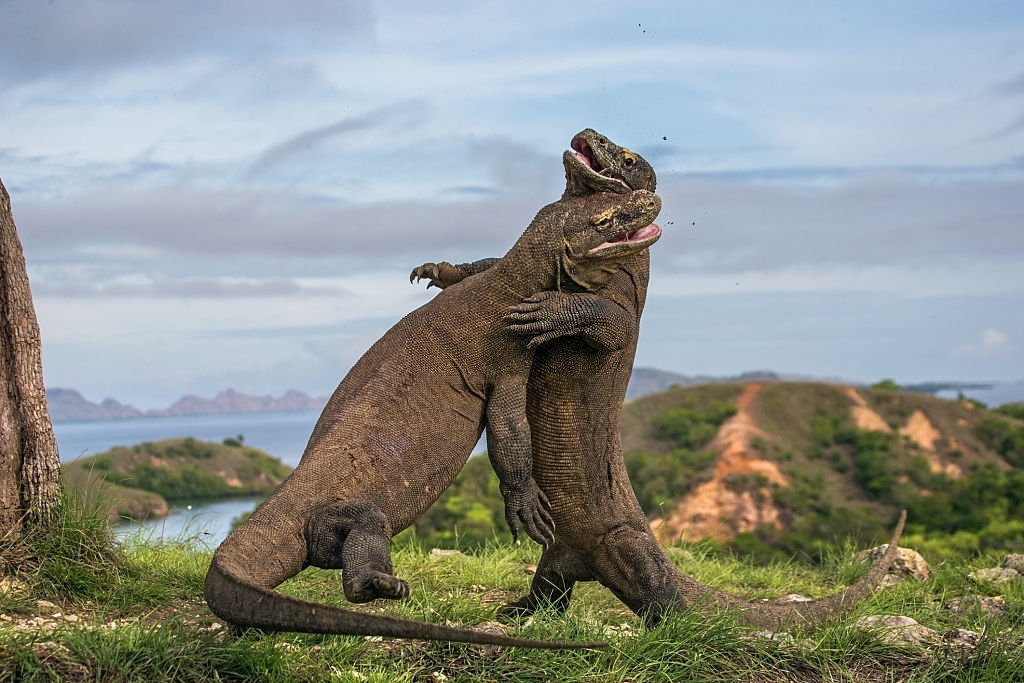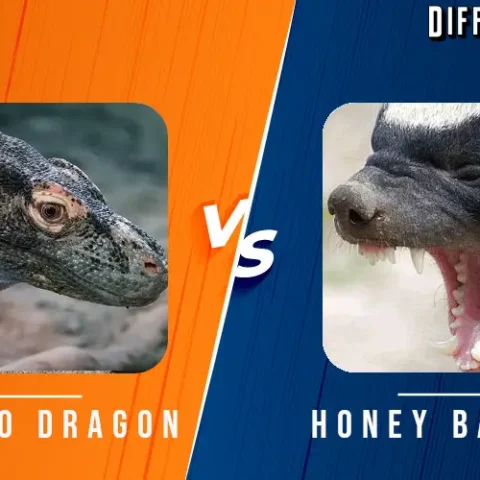Post Contents
Physical and Behavioral Traits: badger vs komodo dragon
What do Komodo Dragon looks like?
Komodo Dragons are the largest member of the lizard family; having a body length of about 3 meters and weigh up to 165 kg. Young Komodos are green colored having yellow and black stripes. They are muscular, hard-skinned, long-tailed reptiles; they have sharp teeth like a shark and have venomous saliva. They have a round head and have ear openings. Male Komodo dragon is larger and heavier than their female counterparts.
They are not territorial animal rather they have home ranges which can be 2 square kilometers; often their home ranges overlap and any komodo can pass, hunt or live in the range. After the hunt, the most dominant Komodo dragon eats first; then smaller males and females eat and lastly the young Komodo dragon which live on trees eat the leftover. They live in burrows to protect themselves from scorching heat

How do Honey badger looks like?
Honey badger also belong to the Mustelidae family; they have a stocky body, large skull, muscular neck, small eyes, and shoulder-length of about 25 cm. The honey badger has thick skin which is about 6 mm thick to protect themselves from predators’ venomous bite and grasp. Honey badger’s half body is black colored whereas its back is grey or white. Sexual dimorphism is present in honey badgers; females are smaller than males. They have an average body length of about 60-70 cm, weighing 8-12 kg.
Honey badger lives alone; they are nomadic and solitary. They meet only during mating season, male honey badgers defend their burrows by marking them with its distinct smell.
Diet: badger vs komodo dragon
What is Komodo dragon favorite food?
Komodo dragon’s diet consists of a large animal such as deer, horses, pigs, water buffalo, goats, wild boar etc. They hunt their prey by ambushing them, when the prey comes in the range, they charge and bite them. After biting komodo dragon follow their prey; as komodo have potent venom, after some time prey becomes weak and dies. They swallow the large species of meat and eat almost every part of its prey including the head. Young Komodo dragon feeds on small animals and insects.Komodo dragon has a long sharp forked tongue with scaly skin that has small bones;Their tongue gathers particles in the air, and delivers vital signs of prey.
What do badger’s eat?
Honey badgers are omnivorous; they are opportunistic foragers. Their diet comprise of rodents, snakes, eggs, dead carcasses, birds, fruits, berries, roots, etc.
Habitat:
Where do we find Komodo dragon?
Komodo dragons live in a varied habitat which includes open lowlands, ridge tops, beaches, dry riverbed and tropical savannah forests. are only found in the harsh climate of the Lesser Sunda Region of Indonesia. They live in tropical forest and are found all across the Islands of Komodo, Flores, Rinca and Padar.
Where do Honey Badger live?
Honey badger lives in a varied habitat which includes grasslands, woodlands, green forests, arid steppes, deserts, rocky hills, thorn forest, etc. They take shelter in rock crevices, caves, burrows; however, they don’t live in extreme desert conditions or the Mediterranean. Honey badgers have wide distribution; they are found in sub-Saharan Africa, Saudi Arabia, Iraq, Iran, Oman, Syria, Yemen, UAE, Jordan, Israel, India, Nepal, Pakistan, Turkmenistan, Afghanistan, Uzbekistan, and Kazakhstan.

Fun Facts for kids:
Some interesting Komodo dragon facts?
- Young Komodos are arboreal and live on trees until they became 8-9 months old.
- Komodo dragon is cannibalistic in nature.
- Komodo dragon’s saliva has more than 50 strains of bacteria which make its saliva a potent venom.
Some interesting facts about badger?
- Honey badger is immune to snake venom including king cobra’s venom.
- Like a skunk, honey badgers also gland in their backside which they use to mark their territory and to keep predators away.
- Honey badger has the “Guinness Book record” for being “world’s most fearless animal”.
- Honey Badgers are voracious eaters; they can eat anything.

Badger vs komodo dragon: Who would win?
The battle Komodo dragon vs Honey badger will be the most interesting and exciting one. On the one side, we have the largest-muscular-venomous lizard whereas on the other the Guinness book world record holder of the “most ferocious animal”, the Honey badger. The possibility of the natural encounter of these two animals is close to nil as they both are found in a different habitat. But, if in case one-on-one battle happens between them; who would win?
In comparison to honey badger, Komodo dragon is quite large and weigh more. Honey badger is immune to the venom of different snakes including king cobra; they have very sharp teeth, tough-hard skin, clawed limbs and is very agile. Honey badger has a gland at the base of their tail through which it sprays a strong suffocating liquid that keeps the predators away. When komodo dragon would confront the honey badger and try to kill it, the honey badger will retaliate aggressively.There are 12 sub species of badger all known as an elite defensive animal that is hyper-aggressive and without fear.
It can dodge the attack of the Komodo dragon through its aggressive agility; it would be hard for komodo to bite the badger; even if it manages to bite, it would not do much harm to honey badger as it is immune to infectious venomous bite. While if a badger gets a chance to bite the komodo it will inflict severe damage to the komodo. Honey badger can fight Komodo dragon for a long-time as it has excellent stamina and never to give up attitude. honey badgers keep on fighting until the attacker gets tired and gives up hope. Hence, the honey badger “the world’s most ferocious animal” is the winner of the duel. However there are low chances for either of them to die.Badgers fight with the help of their intelligence powerful teeth, jaws and claws in comparison to the Komodo dragon dragons 60 sharp, serrated teeth in their jaws
Comparison Chart: Komodo Dragon vs Honey Badger
| Comparison Heads | Komodo Dragon | Honey badger |
|---|---|---|
| Kingdom | Animalia | Animalia |
| Phylum | Chordata | Chordata |
| Class | Reptilia | Mammalia |
| Order | Squamata | Carnivora |
| Family | Varanidae | Mustelidae |
| Genus | Varanu$ | Mellivora |
| Species | V. Komodoensis | M. Capensis |
| Found in | Lesser Sunda Region of Indonesia | Sub-Saharan Africa and Some parts of Asia |
| Weight | About 360 lbs | 17-27 lbs |
| Body Length | 3 metres | 55-77 cm |
| Lifespan | About 30 years | 24 years |
Comparison Video: Honey Badger vs Komodo Dragon
FAQ’s-Frequently Asked Questions
-
What can beat a Komodo dragon?
Anacondas can beat komodos, Anacondas can grow like 29 feet long and 500 pounds compared with 10 feet and 330 pounds.
-
Can a honey badger kill a Komodo dragon?
Yes, Honey badger are more fierce animals than the Komodo dragon, so they can beat the him.
-
Is Komodo dragon bite always fatal?
Since long its has been believed that Komodo dragon bites were fatal because of toxic bacteria present in their mouths. But new research at the University of Queensland has unveiled that the mouth and tongue of Komodo Monitor is surprisingly ordinary.
-
Can a Komodo dragon be tamed?
In general, we cannot tame Komodo Dragon, they are not friendly Lizard species like gecko or Bearded Dragon.
-
Can you domesticate a badger?
Badger’s are small predators and omnivore in the wild, and its a protected species, legally you can’t tame it.
